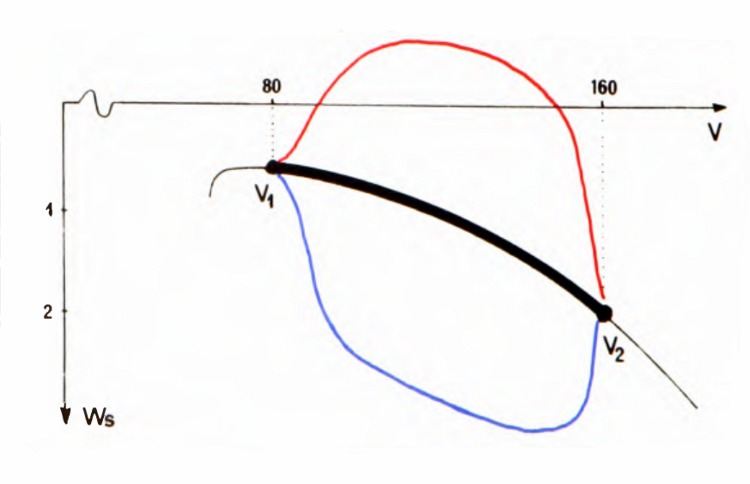
Article details
- Posted by: Aitor Castro
- Tags: energy compensation, thermal hunter
- Difficulty: Advanced
- Updated: September 12, 2018
- Title: Unreliability of total energy variometer
- Description: TE variometers
- Skills: Physics
The total energy variometer takes into account the dynamic energy exchanges with both horizontal and vertical motions of air. So, their indications are gathered together and delayed misleading the information necessary for the location of thermals.
How works a TE variometer
While rate of climb indicators show altitude changes and hence changes in the potential energy of the sailplane, total-energy variometers indicate changes in the total energy of the sailplane, that is, both its potential energy (due to altitude) and its kinetic energy (due to airspeed). The great advantage of the total-energy variometer is that airspeed changes, which are basically exchanges between \( E_{kin} \), and \( E_{pot} \), are no longer displayed. Thus, we can read if we gain or lose energy even if we are slowing or accelerating. This makes it much simpler to locate lift as energy-increase areas.
The picture above represents two points of the polar curve of a glider. When we increase the speed of our glider in still air we move from point V₁ to point V₂ following the blue line and not the polar curve line. The glider follows the constant total energy curve. The glider has to loose height to increase its kinetic energy. A normal vario will indicate an “extra” descent rate as if we were in sinking air.
When we decrease speed we move in the opposite direction algong the red line. A normal vario will detect a fictitious upward vertical motion of air. A TE vario discounts the changes in kinetic energy from the climb/descent indication making the travel through the polar curve line.
Horizontally moving air
Unfortunately there is another kind of influence on total energy imposed by the atmosphere: the gain or loss of kinetic energy by a sudden increase or decrease of the aircraft’s velocity with reference to air by horizontal gusts or wind shear.
Every pilot knows the effect of the wind gradient on landing. The glider is descending into a decreasing headwind caused by friction between the wind and the surface. The result is a decrease in air speed and sink rate may increase significantly to regain air speed or in an extreme case the glider may stall. Even worse if turning too steeply on final approach. There is less wind across the lower wing than across the higher wing and may roll the glider past a vertical bank.
A headwind gust causes the opposite effect. Air speed increases so there’s a kinetic energy gain. This jump in “energy” is seen by the TE variometer exactly the same way as if the glider had made an equivalent jump in altitude at constant velocity. The TE variometer cannot discriminate between the two sorts of energy change. Shortly after, the glider will restore its previous airspeed causing a jump, and so a climb rate change indicated by the normal vario, leading the pilot into believing that he’s entering a thermal.
Airspace te-variometer does not take into account kinetic energy changes due to horizontal gusts.
An air speed change, represented by dV, results in an increase of the kinetic energy of m∙V∙dV. For the total energy to remain constant there must be the same decrease in potential energy m∙g∙dH where g is the gravitational constant and dH is the altitude gain.
$$m \cdot V \cdot dV + m \cdot g \cdot dH = 0 \Rightarrow dH = -\frac{V \cdot dV}{g}$$
This fictious climb rate is discounted from the vario climb rate indication obtaining the discounted climb rate which serves to detect the real vertical motion of air. The discounted climb rate indication won’t reflect the climb rate of our glider anymore except in the case of constant airspeed and in the absence of horizontal gusts. Most pilots miss the old glider climb rate indication so in Airspace we’ve managed to give the pilot both indications in an audible and novel manner:
The frequency and duration of vario tones follow smoothly the climb/descent rate of the glider as in a normal vario but when the fictious climb rate is negative there’s a sudden increase in the frequency of tones signaling the pilot a real upward motion of air. A positive discounted climb rate despite being descending is a good indication of the proximity of a thermal. In this case the airspace app will inform the pilot with a special audible tone. It’s what we call the thermal hunter
Read more
- François Ragot. Unsuitability of existing TE variometers for dynamic soaring. OSTIV Congress 1981.
- Rudolf Brözel. Total energy Kompensation. September 1985.
- Taras Kiceniuk. A variometer for dynamic soaring. Technical Soaring, volume 25, number 4, October 2001.
- François Ragot. Best speed story, page 12, left column, Technical Soaring, volume 28, Numbers 1 /2, January/April 2004.